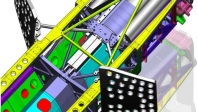
The airbrakes in BLOODHOUND SSC are located either side of the Car in front of the rear wheels. They are made from carbon fibre and will experience around 5 tonnes of load at speeds of up to 800mph.
One of the prime advantages of airbrakes is that they are mechanically straightforward to operate. But the problem with using them in BLOODHOUND is that in order to stop the Car in the available distance of 5.5 miles (8.8km), they must virtually double the cross-sectional area and drag of the car, and that represents a significant technical challenge.
The result is that BLOODHOUND’s airbrakes are the biggest ever seen in land speed racing.
How they work
The airbrake doors need to be moved out into the airflow at a very specific rate in order to maintain the G force on the Car at just under 3g – which is the equivalent of slowing it down by 60mph every second.
Each door is moved by a separate huge hydraulic ram. However, it’s also vital that they open symmetrically, so the twin hydraulic pistons drive a single slider plate, which in turn is connected to both airbrake doors so that both move together.
For safety, each door also has its own separate accumulator that acts as a form of backup in case the main hydraulics fail.
Perforations in the airbrakes help break up the airflow, which will reduce the trauma on the rear wheel assemblies.


